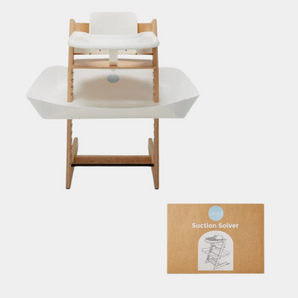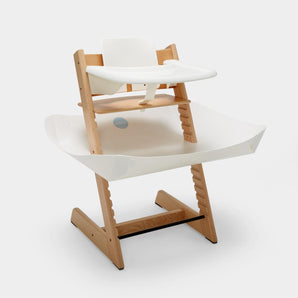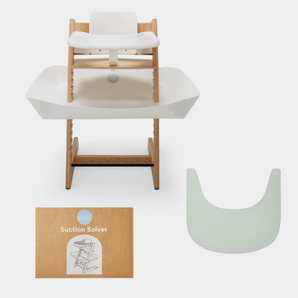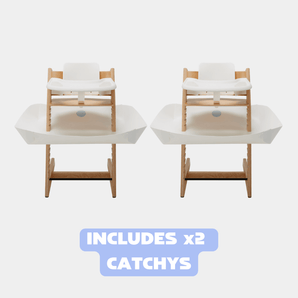Below you will find sample feeding schedules for babies 3-24 months of age. Once baby shows the signs of readiness for solid food, many questions arise. How many meals a day does baby need? How does that affect how much breast milk or formula baby should get? Answers to these questions and more below.
New here? We are a team of licensed pediatricians, feeding therapists, dietitians and an allergist and our mission is to help you introduce real food to your baby and raise a happy eater. Just starting solids? Be sure to download the Solid Starts App.
Bottle-Feeding Schedules
Research shows a wide range of "normal" for daily milk intake, including bottles per day and volume per bottle. Follow baby's lead; if baby is growing well, peeing and pooping as expected, and thriving overall, then baby is likely consuming what they need, even if it differs from the amounts below.
Note: This section is specific to bottle-feeding with expressed breast milk and/or formula. See Breastfeeding On-Demand Schedules for information on starting solids and breastfeeding on-demand. For combined breast- and bottle-feeding, follow the bottle-feeding schedule below as a rough guide.
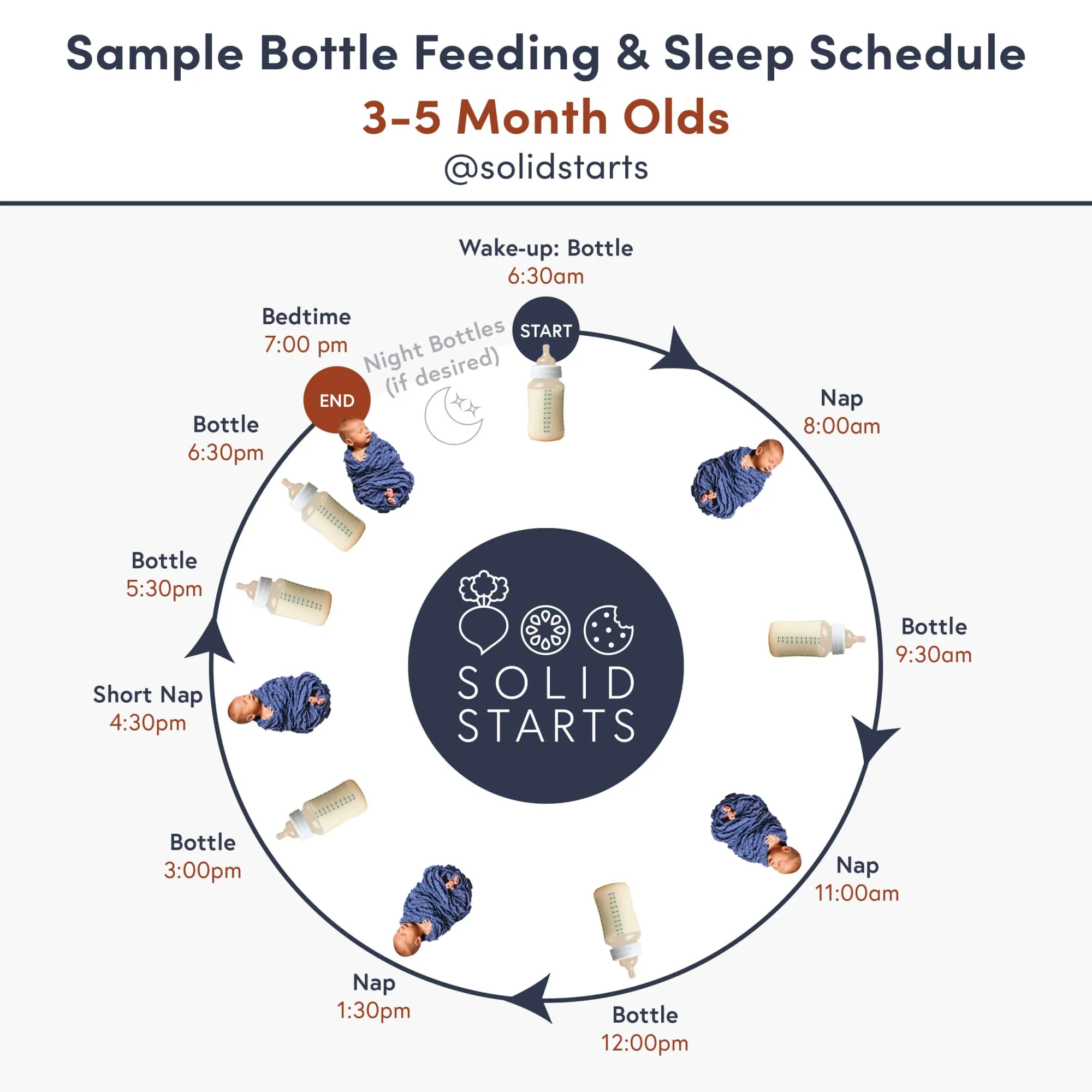
3 to 5 Months Old Feeding Schedule: Pre-Solids
Expressed breast milk or formula: ~24 to 32 fluid ounces (710 to 946 milliliters) per day on average
Solid meals: None until showing all signs of readiness.
Baby is likely bottle-feeding six to eight times per day, with most still taking one or more bottles during the night. Structure the day with baby to introduce the idea of food, eating, and family mealtimes—even before starting solids. There is no need to implement a firm schedule; however, a flexible but consistent daily routine is helpful for both baby and parents. Baby is likely awake for about 1.5 hours at a time and many babies will nap three or four times a day.
Note: Some infants may drink more than the range shown above, especially during growth spurts. Some infants may drink less. As long as baby is growing appropriately, there is no need to worry about volume.
Ideas to Help Prepare Baby for Solids:
-
Bring baby to the table while you eat. Bring baby near the table while you eat, and if you like, sit baby on your lap during the meal. Let them smell the food and drinks, watch you bring food to your mouth, and talk about the meal. Baby may show some interest in tasting what you’re eating. If your baby’s doctor has given you the green light, you might consider sharing small tastes of fresh foods for baby to lick. Avoid chunks of food or food bites that need chewing—at these young ages, opt for small tastes that are easily swallowed with saliva.
-
Floor play: It’s important at this age to give baby lots of floor time to strengthen their core in preparation for sitting. Allow baby the opportunity to play on their back, side, and tummy. Encourage reaching and grasping activities by hanging toys above baby's head; this lets them practice using their arms and hands in preparation for grabbing food.
-
Let baby watch, smell, and hear food preparation in a safe infant seat, carrier, or on the kitchen floor. Describe the foods you are preparing so baby hears descriptive words about food (hot, cold, sour, sweet, salty).
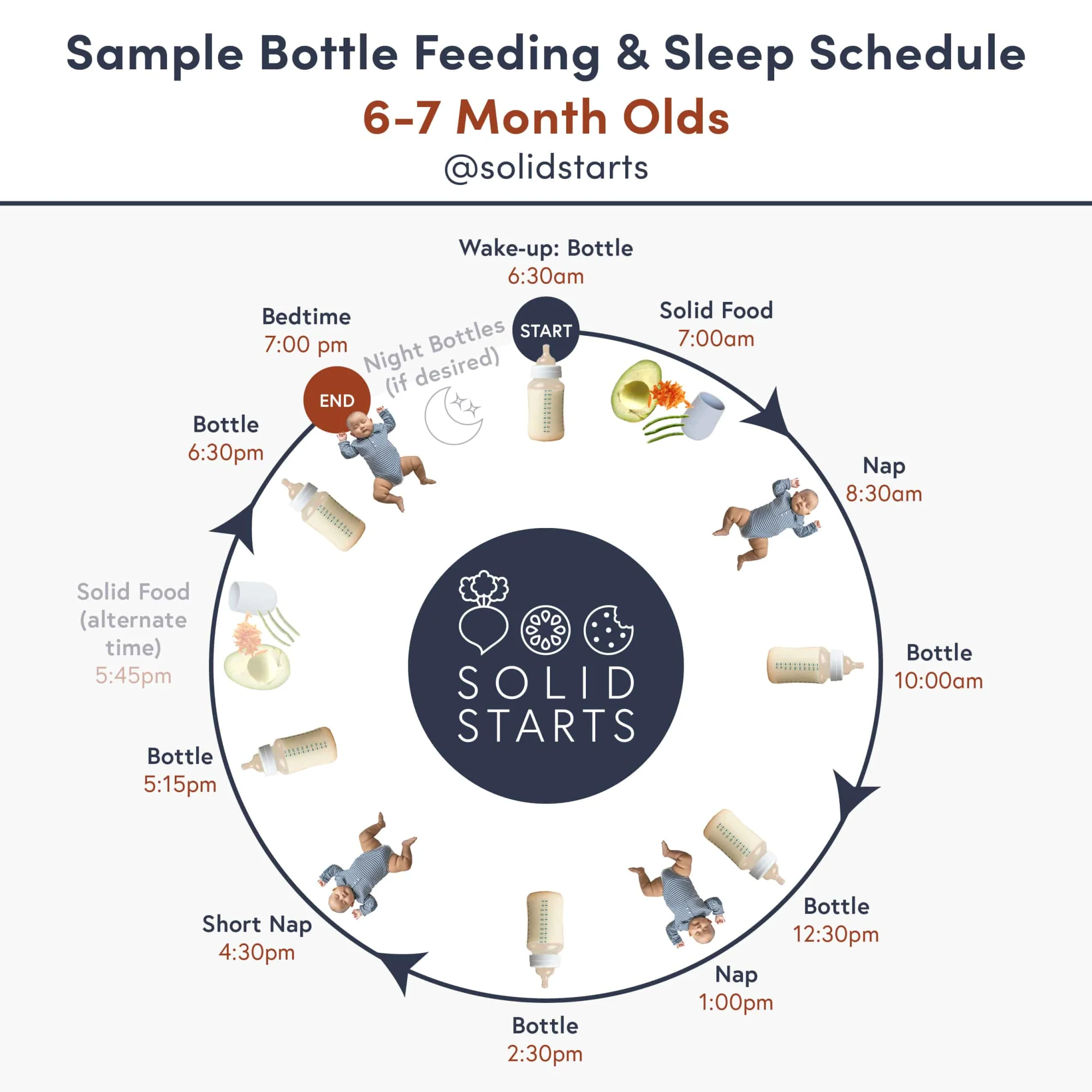
6 to 7 Months Old Feeding Schedule
Expressed breast milk or formula: 24 to 32 fluid ounces (710 to 946 milliliters) per day
Solids: 1 to 2 meals
Baby is likely bottle-feeding six to eight times per day, with most still taking one or more bottles during the night. If your baby is taking more or less than this number of bottles and is growing well, peeing and pooping as expected, and overall thriving, then you are likely feeding just the right amount for your baby. Your baby should not decrease the number of bottles they are taking yet, even with the new addition of a solid food meal. When first starting solids, breast/human milk or formula should still be baby’s primary source of nutrition.
We recommend one mealtime per day at this age, though if you and baby have the time in your day and both enjoy being at the table, you are welcome to offer solids twice a day. You might need to offer a "top-off" bottle after solids if baby still exhibits hunger, as many babies will not eat much during meals at this age. Eating solid food at this stage will mainly be for practice, so try not to worry about consumption. Remember, we use the word "meal" to describe times baby is at the table exploring food. Even if baby does not swallow anything, this is still considered a "meal."
Baby is likely awake for about 2-2.5 hours at a time and most babies will nap three times a day. If you want to disassociate sleeping and eating (i.e., trying to avoid baby falling asleep on the bottle at naptime), it’s best to offer any top-off bottle at least 30 minutes before baby’s next naptime, and keep baby awake during the feed. Baby is also offered a bottle as part of the bedtime routine in this sample schedule; however, if your goal is to separate eating and sleep, then consider offering the bottle as the first part of the routine – just before a bath and bedtime stories – to avoid the feed-to-sleep association.
Pick a mealtime where baby is happy, playful, and well-rested. We want baby to associate the table with happiness and have the energy and gusto to learn how to eat food. Mealtime doesn’t have to be the same meal each day—you may do breakfast during the week and lunch on the weekend. That’s okay. It’s also completely okay if a day goes by without offering solid food because you or baby are having a tough day, or it just doesn’t work in the schedule. We recommend starting by offering breast/human milk or formula as an appetizer 30 minutes prior to meals so baby isn't overly hungry and frustrated. If baby is still hungry after solids, wait another 15-20 minutes and offer more breast/human milk or formula as a dessert or top-off. This helps take the edge off and ensures baby isn’t overly hungry or too full for the solid meal.
At this age, you can start offering small amounts of water in an open cup and a straw cup, alternating the cup style at each meal. Limit water to less than 2 ounces (60 milliliters) at each meal, with no more than 4 ounces (118 milliliters) per day, unless otherwise advised by your pediatrician. It’s okay to practice with expressed breast/human milk or formula, but be aware that spills are very common at this age. For more on teaching baby to drink from a cup and straw, see our Cup Drinking page or our videos in the Starting Solids Bundle.
Note: Some infants may drink more than the ounces listed above, especially during growth spurts. Some infants may drink less. As long as baby is growing appropriately, there is no need to worry about volume.

8 to 9 Months Old Feeding Schedule
Expressed breast milk or formula: 24 to 32 fluid ounces (710 to 946 milliliters) per day
Solids: 2 meals
Baby is likely bottle-feeding five to eight times per day, with most still taking one or more bottles during the night. At this age, some babies may be more confident eating solid food, but breast milk and formula should remain baby’s primary source of nutrition. Although baby may be drinking slightly less, you shouldn’t see a large drop in milk feeds; some babies do not change their milk intake at all yet. If you have noticed a large drop, consider offering fewer solid foods. Breast milk or formula is still important at this age, and weaning should be slow.
Baby is likely awake for about 2.5-3 hours at a time, and most babies will nap two times a day, though some 8-month-old babies hang on to their third nap a little longer, until around 9 months of age.
Please note that many babies and parents prefer to offer bottles right before nap as part of the nap routine. This works as well. Our sample schedule shows separate naps and bottles for those who choose to disassociate sleep and eating (i.e., trying to avoid baby falling asleep on the bottle). However, if this is not a priority for you and your family prefers bottles as part of the sleep routine, you can modify the timing of bottles accordingly.
If you have yet to offer two solid meals per day, this is a good time to do so. Continue offering meals when baby is in a good mood, well-rested, and interested in eating. It’s totally okay to skip a meal here or there. Consider allowing baby to come to the table a little hungry, with an hour or so between bottle feeds and table foods; this encourages baby to learn that food can fill their tummy. Babies may need a “top-off” feed of breast milk or formula after a meal but expect this to decrease over time.
If you are already offering 3-4 solid meals per day and baby is happy with this, taking the recommended volumes of formula or expressed breast milk, and is regularly peeing and pooping, then this is likely just fine for your baby. Keep in mind that, between 9-12 months, baby should be progressing their chewing skills, and if purees were the primary food source from 6-7 months, it’s time to move towards chewable foods. As you introduce chewables or gradually progress in the complexity of the chewable foods you offer, you might see a decrease in the amount of solid foods actually swallowed at each meal. If this is the case, you would also expect an increase in the amount of formula or breast milk the baby is taking in, so keep an eye out for this and add in an extra bottle or extra volume in each bottle as needed.
Continue offering small amounts of water (or breast milk or formula) in an open or straw cup at mealtimes, alternating between open and straw cups for practice. (See our Cup Drinking page for more information.)
Note: Some infants may drink more than the ounces listed above, especially during growth spurts. Some infants may drink less. As long as baby is growing appropriately, there is no need to worry about volume.
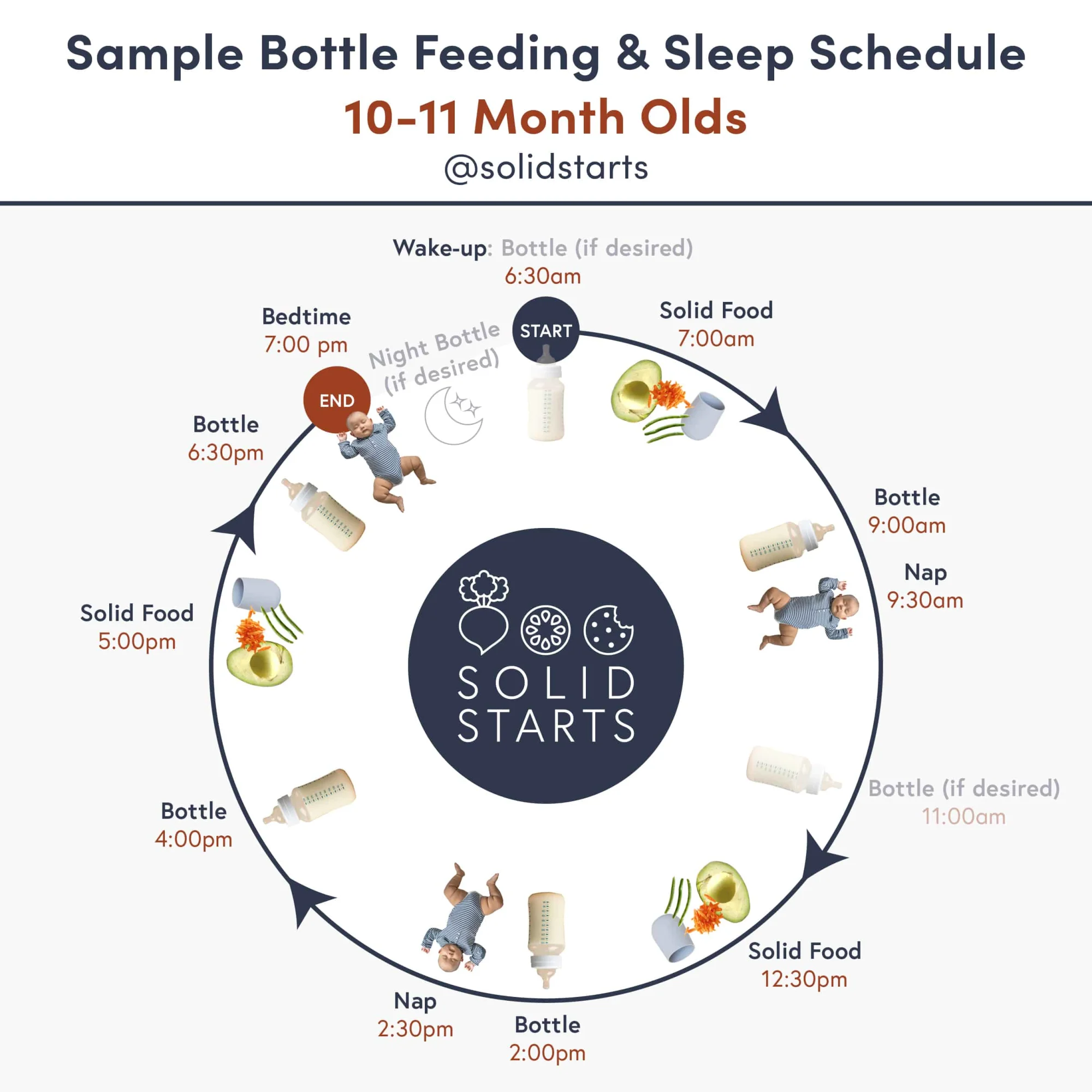
10 to 11 Months Old Feeding Schedule
Expressed breast milk or formula: 20 to 30 fluid ounces (591 to 887 milliliters)
Solids: 3 meals
Aim to offer three solid food meals each day along with breast milk or formula distributed across four or more bottle feeds. For babies who enthusiastically embrace breakfast, you may find you can start reducing the first bottle of the day (or drop it entirely and take baby straight to breakfast upon waking).
Baby is likely awake for about 2.75-3 hours at a time, and most babies will nap two times a day.
Continue offering breast milk, formula, or water in an open or straw cup with meals, alternating between open and straw cups for practice. (See our Cup Drinking page for more information.) Around 11 to 12 months of age, small amounts of cow milk may be offered in an open cup to acclimate baby to its taste. If baby doesn’t seem hungry for solids, is approaching 12 months of age, and otherwise gaining weight and in good health, consider slowly reducing the amount of breast milk or formula in each bottle or cutting out a bottle feed. As always, discuss baby’s schedule with a pediatrician or health care provider.
If they have not already, babies should be progressing at this age away from purees and mashes towards finger food that resembles what the adults in the family eat at most meals. If your baby was eating purees and mashes well and had weaned down their formula or expressed breast milk intake accordingly but doesn’t yet have the skills to eat chewable foods, you may want to consider keeping most solid foods experiences as chewables and finger foods right now in order to support your baby in building these crucial skills. Because this will likely lead to less solid food intake for now, we recommend continuing with normal amounts of formula or breast milk and not supplementing with purees. Some babies may even need more formula or breast/human milk than they were previously taking as they build these skills. Topping off with purees may teach your baby that the more challenging-to-chew foods are not worth putting in the extra effort to explore and learn, since they know the easier-to-eat food is coming next. Formula is a more ideal supplement than purees at this age, since it is made to provide more complete nutrition. To avoid this same connection with bottle feeding, make sure you don’t offer an immediate bottle after the meal—wait 30-60 minutes after the table meal, then offer any top-off bottles.
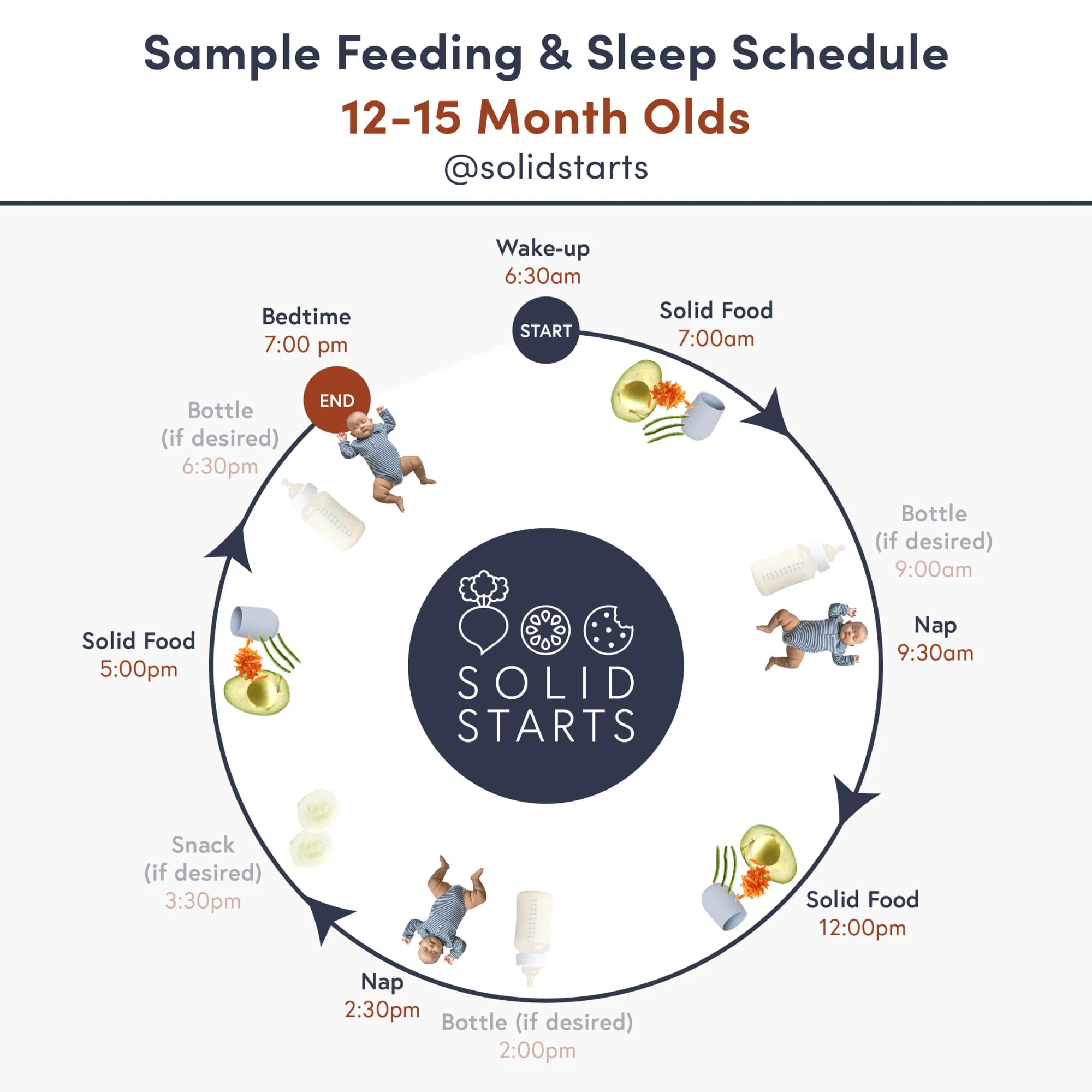
12 to 15 Months Old Feeding Schedule
Expressed breast milk or cow's milk: Anywhere from none to 14 to 20 fluid ounces (414 to 591 milliliters)
Infant formula: No more than 16 fluid ounces (473 milliliters); 15 months+ ideally none
Solids: 3 meals + 2 optional snacks
Solid foods are starting to become the primary source of nutrition at this age, and the solid food meal should ideally be offered before any milk feeds. The toddler should eat three meals of solid foods each day, and many take two snacks situated halfway between meals. Keep in mind that this does not have to be a hard stop on bottles or on formula or breast/human milk right at 12 months old. Some babies will continue to need a few bottles per day to get adequate nutrition and energy while they continue to build their chewing and eating skills. The goal is to wean all bottles and all formula by 15 months. If you would like to continue offering expressed breast/human milk at that point, you would aim to offer it in a cup at table meals. For more on how to wean, take a look at our guide on How to Wean from Breast or Bottle.
Note: Some toddlers will drop the morning nap in this age range. Most toddlers do best with a 2-nap schedule until closer to 16-18 months, but certainly, some children are ready to drop one of their naps a bit earlier. Trust baby and your gut, and adapt the schedule as necessary. When your child does move to a 1-nap schedule, occurring midday (around noon), offer lunch before naptime to ensure hunger is not an issue causing a difficult or short nap.
Breast milk or formula feeds should be limited to about 16 ounces (473 milliliters) per day to avoid displacing nutrients from solid food. However, if a toddler is eating all three solid meals a day enthusiastically and wants more breast milk, go for it. While breast milk alone is no longer an adequate source of nutrients for a toddler, there are many other health benefits to extended breastfeeding as long as the child consumes various other foods to provide both calcium and vitamin D.
While many families don’t entirely wean off bottles and formula until closer to 14 or 15 months of age, discuss the child’s feeding schedule with a pediatrician or health care professional if you are still bottle feeding after 15 months of age. Generally, we like to see all bottles dropped entirely by 15 months of age at the latest. (For more on milk, see our Milk FAQs.)
A word on cow’s milk: Never put cow’s milk in a bottle. If you believe baby continues to need a bottle, consider keeping formula or breast milk in that bottle while practicing with cow's milk in a cup at the table, then weaning the bottle and any formula at the same time over the next few months. Remember, formula or breast milk is more nutritionally complete, while cow's milk is not and when taken in large quantities, can lead to constipation and nutritional deficiencies such as iron deficient anemia. Limit consumption of cow’s milk to 16 ounces (473 milliliters) per day. One way to keep within this limit: remind yourself that milk is a drink that accompanies a meal and not a meal itself. Only serve milk in a cup with meals. While you don’t have to offer cow’s milk, it does bring a good amount of protein, fat, calcium, and vitamin D to the table. If you’d like to forgo cow’s milk and dairy entirely, make sure to offer other sources of calcium and vitamin D. See our Nutrient Cheat Sheet for a list of foods by nutrient.
For more on milk and milk alternatives, see our Milk FAQs.
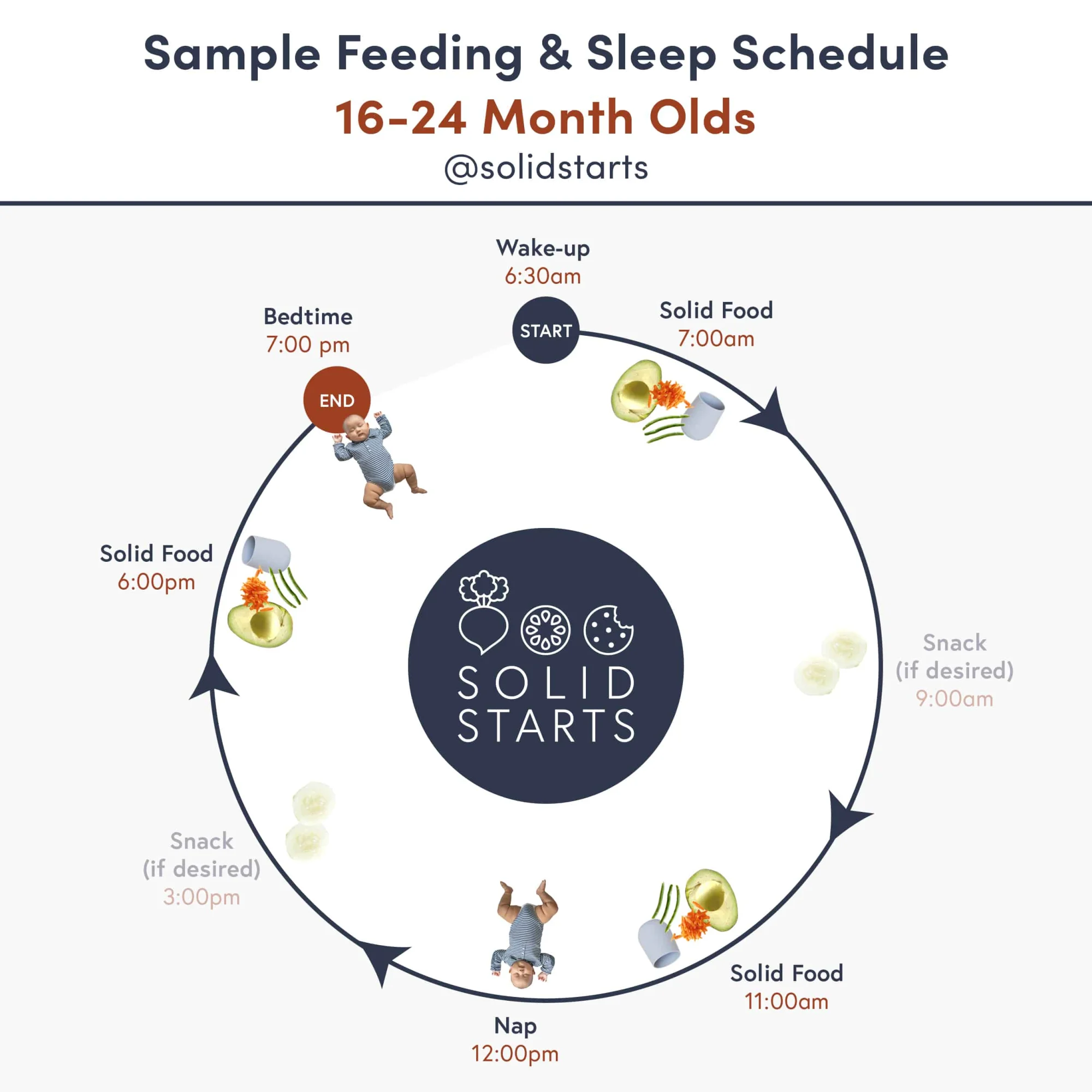
16 to 24 Months Old Feeding Schedule
Expressed breast milk or cow's milk: 16 fluid ounces (473 milliliters) maximum
Infant formula: None, unless otherwise recommended by a child's medical provider
Solids: 3 meals + 2 snacks
By 16 months of age, the child should continue eating three meals of solid foods each day and two snacks between meals. The AAP advises that bottles and formula should be weaned by this age. Limit milk consumption (breast milk or cow’s milk) to no more than 16 ounces (473 milliliters) per day to avoid displacing nutrients obtained from solid food and serve alongside a meal as a beverage, not as a separate meal. If your toddler happily eats all three meals and two snacks a day and wants more breast/human milk, go for it. Keep an eye on solids consumption to ensure that none of the milk feeds affect the intake and interest in solids.
If your toddler is still bottle-feeding at this age or has limited interest in solids, consult your pediatrician or health care professional.
Note: At this age, breast milk is not an adequate source of calcium and vitamin D. Although there are many other health benefits to extended breastfeeding, it’s important to offer various foods that provide both calcium and vitamin D.
A word on cow’s milk: Never put cow’s milk in a bottle. At this age, serve cow’s milk in an open or straw cup, but limit consumption of cow’s milk to 16 ounces (473 milliliters) per day or less, if the child is consuming other sources of dairy such as yogurt or cheese. One way to keep within this limit: remind yourself that milk is a drink that accompanies a meal and not a meal itself. Only serve milk in a cup with meals. While you don’t have to offer cow’s milk, it does bring a good amount of protein, fat, calcium, and vitamin D to the table. If you’d like to forgo cow’s milk and dairy entirely, make sure to offer other sources of calcium and vitamin D. See our Nutrient Cheat Sheet for a list of foods by nutrient.
For more on milk and milk alternatives, see our Milk FAQs.
Breastfeeding on Demand Schedules
Note: This section is specific to breastfeeding on demand. Looking for information about starting solids and bottle feeding? See our Bottle-Feeding & Starting Solids schedules (above). Doing a combination of breastfeeding and bottle-feeding? We suggest following the bottle-feeding schedule as a basic guide.
As a team with four lactation consultants and many moms who have breastfed or are currently breastfeeding on demand, we understand how easy it is to lose track of how many times baby nursed in an hour, much less in an entire day.
Nursing on demand and introducing solid foods can be natural and easy for some and for others can feel like a delicate balance: eventually, we want baby to come to the table hungry enough to be incentivized to taste the food, but not overly hungry so they can focus on learning the skills of how to eat. We have based these recommendations on the available literature, as well as the guidelines developed by the AAP, WHO, and UNICEF. We have also applied our vast experience as experts in the transition to solids and prevention of picky eating while exclusively breastfeeding to tailor these recommendations to support babies in exploring food, developing interest in eating, and eventually, weaning when the time is right for baby and parent.
The literature shows a huge spread of what is considered "normal" in terms of how many times a day a baby nurses. This may also change from day to day. Please keep in mind, if your baby is growing well, peeing and pooping as expected, and overall thriving, then you are likely nursing just the right amount for your baby, even if it is less or more than what is listed below.
Generally, when starting solids while breastfeeding on demand, consider the following: the frequency you breastfeed may not change. If things are going well and baby is interested in exploring food, then moves within a few months towards eating solids well, there’s likely no need to change anything. But as baby moves towards 9+ months old, if baby isn’t beginning to eat a bit more solids at table meals and especially if baby doesn’t seem interested in exploring food or even being at the table, it may be time to consider some strategies to help baby develop more interest in table food. One main reason babies don’t explore solid food is simply because they are not hungry.
Remember, the time between starting solids (around 6 months old) and 12-15 months old is a time for baby to develop and refine eating skills. Building those skills takes consistent and repetitive practice because chewing and eating a wide variety of foods is a remarkably complex activity. This is why the safety net of your breast milk is so important, and why keeping your milk supply stable during this phase is quite helpful.
However, we work with many families who report baby shows zero interest in exploring, tasting, and eating solids from 6-12 months and continues to breastfeed on demand very frequently. While a baby skipping a day of practicing with solids here and there at 6 or 7 months isn’t a big deal, building skills between 6-12 months is quite important overall. Research has shown that if babies do not explore flavors and textures between 6-8 months specifically, they are more likely to refuse them moving forward, and our clinical experience shows chewing delays when infants do not have a drive to explore chewables during the first year. Primary health care providers often see inadequate weight gain in toddlers who struggle with solid food consumption due to lack of early interest and practice and rely too heavily on breast milk.
Regardless of how you go about breastfeeding and starting solids, by around 12-15 months of age, the AAP and WHO both agree that solid food should be the primary source of nutrition for optimal growth and development, whether you choose to continue to breastfeed your toddler on demand or not. And because it can take a baby several months to learn how to eat and develop the interest in solid food, it’s important not to start too late. In other words, don’t wait until 10 or 11 months to really get going with solids. Toddlers are not nearly as open and interested in new flavors and textures as 6-12-month-olds are, so start as soon as baby is showing signs of readiness (typically around 6 months of age) and aim for solids to be the primary source of nutrition, with 3 meals per day, by around 12 months of age.
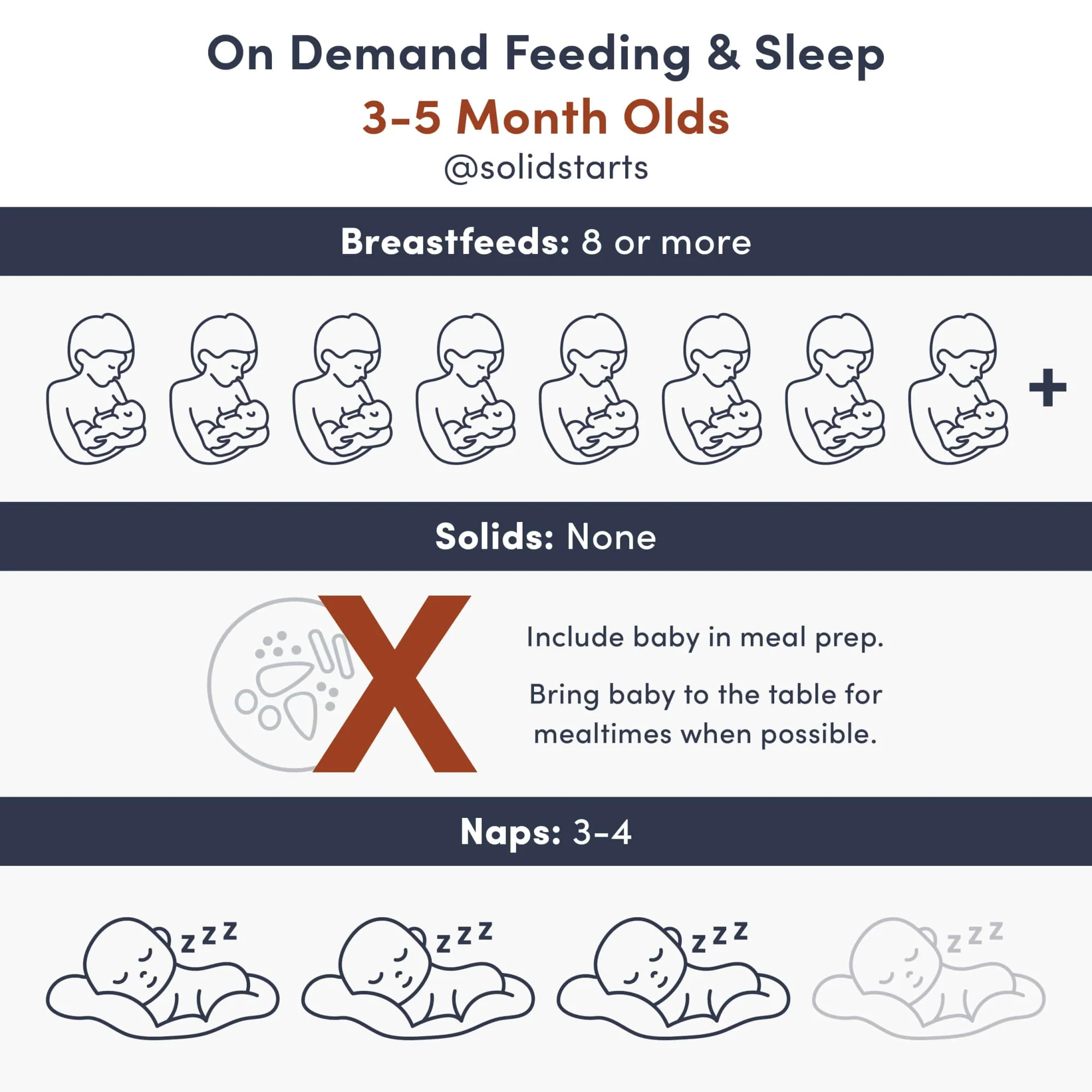
3 to 5 Months Old On-Demand Breastfeeding
Breastfeeds: 8 or more on demand
Solids: None
Baby is likely nursing at least six times per day with most nursing 8-12 times. Structure the day with baby to introduce the idea of food, eating, and family mealtimes—even before starting solids. Baby is likely awake for about 1.5/2 hours at a time and many babies will nap three or four times a day.
Ideas to Help Prepare Baby for Solids:
-
Bring baby to the table while you eat. Bring baby near the table while you eat and if you like, sit baby on your lap during the meal. Let them smell the food and drinks, watch you bring food to your mouth, and talk about the meal. Baby may show some interest in tasting what you’re eating. If you’re baby’s doctor has given you the green light, you might consider sharing small tastes of fresh foods for baby to lick. Avoid chunks of food or food bites that need to be chewed—at these young ages, small tastes that can be easily swallowed with saliva are safe and ideal.
-
Floor play: It’s important at this age to give baby lots of floor time to strengthen their core in preparation for sitting. Give baby the opportunity to play on their back, side, and tummy. Encourage reaching and grasping activities by hanging toys above baby's head; this lets them practice using their arms and hands in preparation for grabbing food.
-
Let baby watch, smell, and hear your food preparation in a safe infant seat, or on the kitchen floor. Describe the foods you are preparing so baby hears descriptive words about food (hot, cold, sour, sweet, salty).
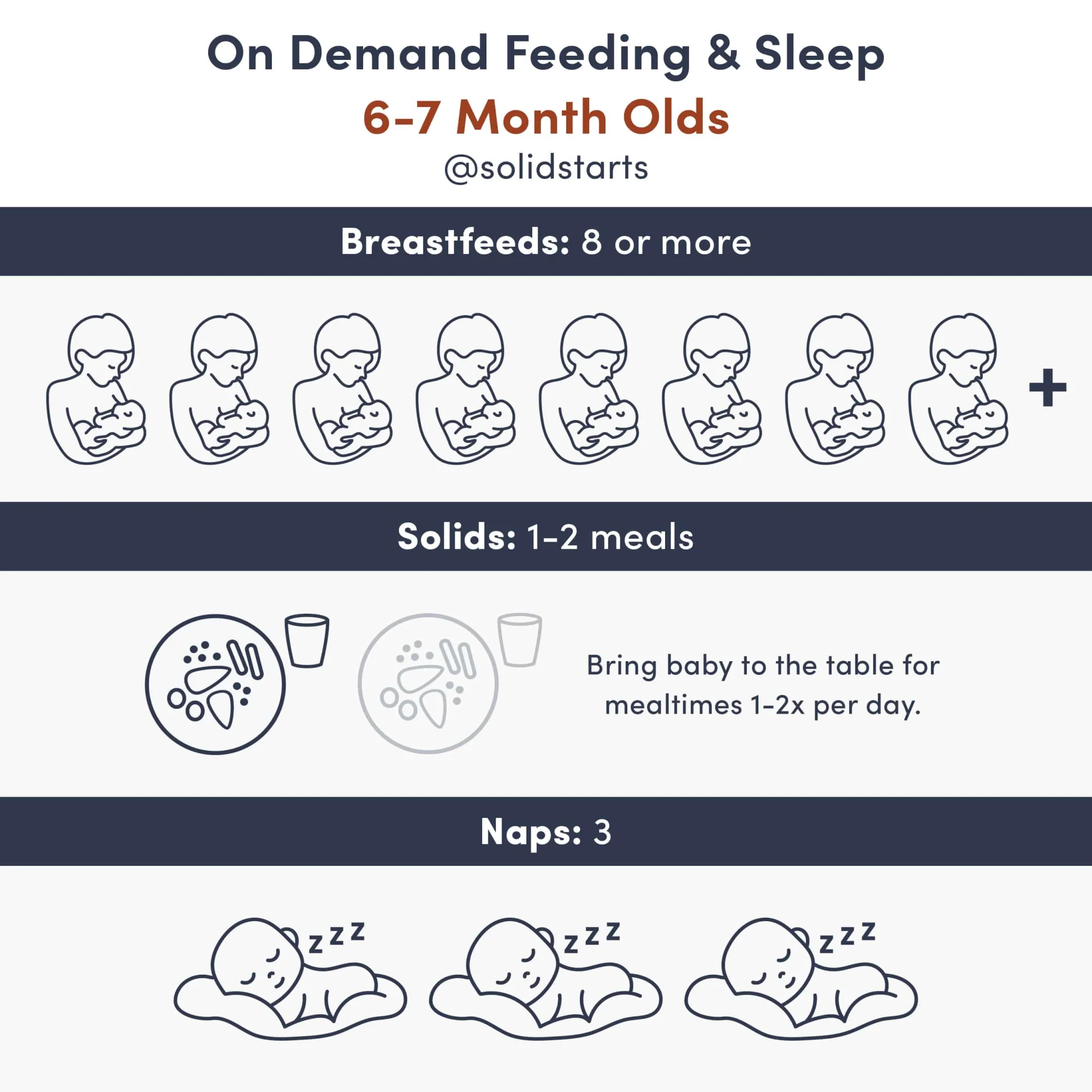
6 to 7 Months Old On-Demand Breastfeeding
Breastfeeds: 8 or more on demand
Solids: 1 to 2 meals
Baby is likely nursing at least six times per day, with most continuing to nurse 8-12 times per day. If you’re enjoying this and baby is growing and thriving, this is fine. Baby is likely awake for about 2-2.5 hours at a time and most babies will nap three times a day.
Pick a mealtime where baby is happy, playful, and well-rested. We want baby to associate the table with happiness and have the energy and gusto to learn how to eat food. This also doesn’t have to be the same meal each day. You may do breakfast during the week and lunch on the weekend. That’s okay. As baby starts learning to eat solids, don't expect much actual intake. Some babies eat more than others, and that is okay and completely normal. At this age, we recommend one to two meals per day with breast/human milk offered upon waking (for the day, or from a nap), and then about one hour offered between nursing and table food, to allow baby to come to the table a bit hungry. Remember, 2 meals are only if baby is enthusiastically embracing solids, if they get tired or frustrated easily, once per day is enough. If baby is too hungry and gets frustrated at the table, offer a short breastfeeding snack before starting the meal. Follow the meal with another breastfeed “top-off” as needed. If you want to disassociate sleeping and eating (i.e., trying to avoid baby falling asleep on the breast at naptime), it’s best to offer the top-off feed at least 30 minutes before baby’s next naptime, and keep baby awake on the breast. Baby is also offered a feed as part of the bedtime routine; however, again, if your goal is to separate eating and sleep, then consider offering the breastfeed as the first part of the routine – just prior to a bath and some bedtime stories – to avoid the feed-to-sleep association.
At this age, you can start to offer small amounts of water in an open cup and a straw cup, alternating the cup style at each meal. Limit water to less than 2 ounces (60 milliliters) at each meal, with no more than 4 ounces (118 milliliters) per day, unless otherwise advised by your pediatrician. It’s also okay to practice with expressed breast/human milk or formula but be aware that spills are very common at this age. For more on teaching baby to drink from a cup and straw, see our Cup Drinking page.
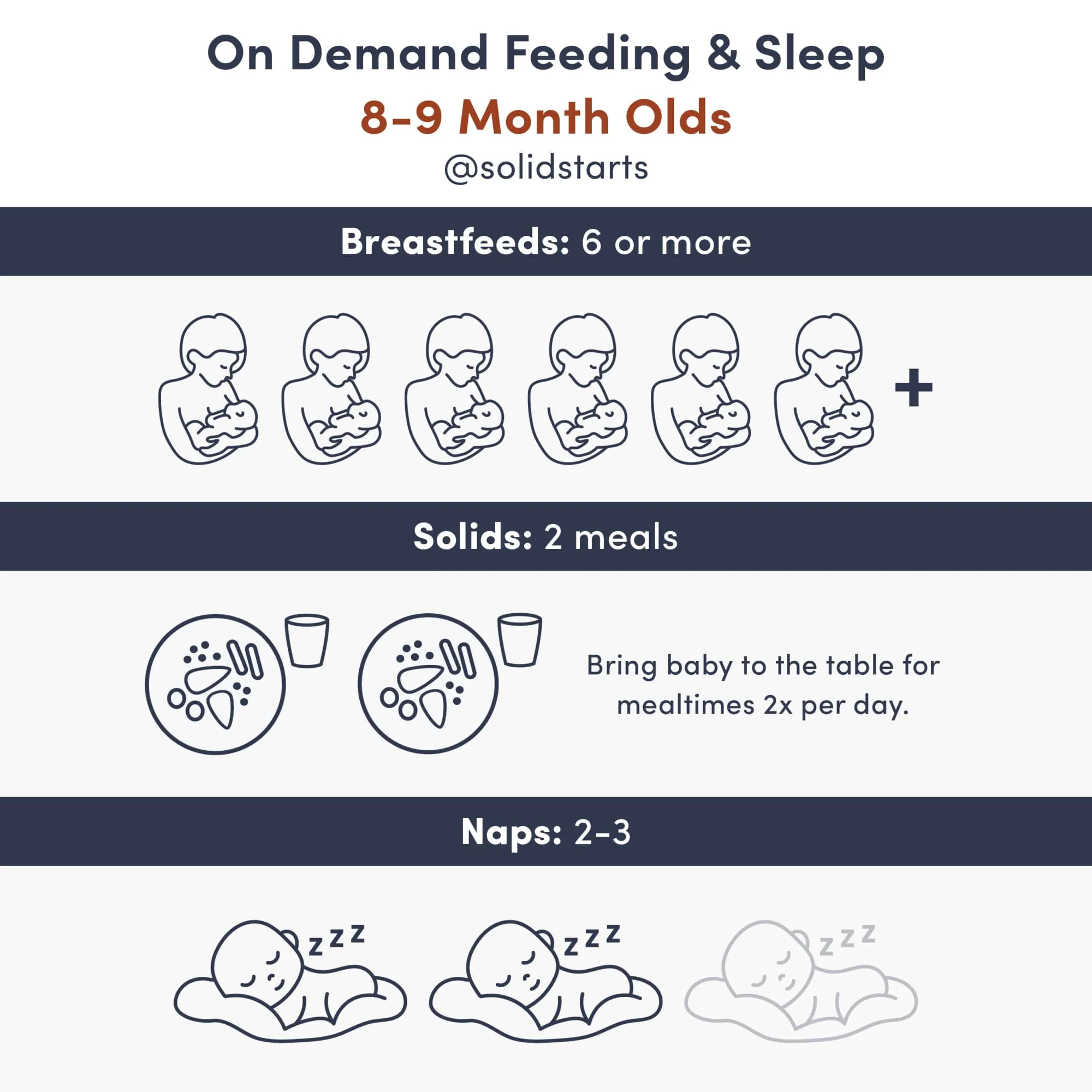
8 to 9 Months Old On-Demand Breastfeeding
Breastfeeds: 6 or more on demand
Solids: 2 meals
Baby is likely nursing at least six times per day, with many continuing to nurse 8-12 times per day. If you're enjoying this and baby is growing and thriving, this is fine. As baby starts learning to eat solids, don't expect much actual intake. Some babies eat more than others, and that is okay and completely normal. Baby is likely awake for about 2.5-3 hours at a time and most babies will nap two times a day, though some 8-month-olds hang on to their third nap a little longer, until around 9 months of age.
If you have not started to offer two solid meals per day, this is a good time to do so. At this age, we recommend one to two meals per day with 1 hour between nursing and table food to allow baby to come to the table a bit hungry. If baby is too hungry and gets frustrated at the table, offer a short breastfeeding snack before starting the meal. Follow the meal with another breastfeed “top-off” as needed.
Continue offering breast/human milk (or small amounts of water) in an open cup or straw cup at mealtimes, alternating between open and straw cups for practice. (See our Cup Drinking page for more information.)
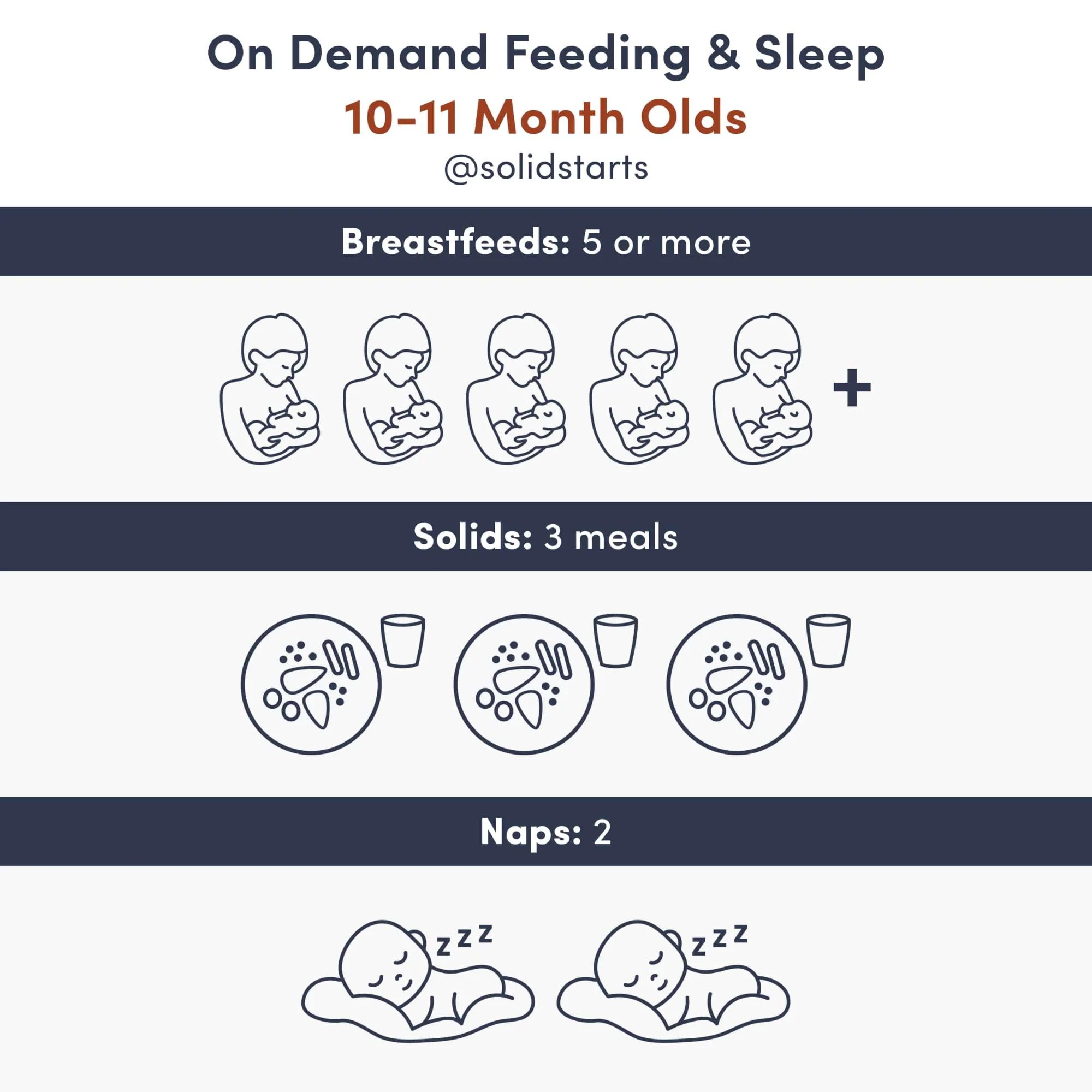
10 to 11 Months Old On-Demand Breastfeeding
Breastfeeds: 5 or more on demand
Solids: 3 meals
Offer three meals of solid food each day along with five (or more) breastfeeds distributed across the day. Many babies continue to nurse 8-12 times per day. If you're enjoying this, baby is growing and thriving, and is interested in exploring table foods, this is fine. Your baby may be attempting more challenging to chew foods at this age as well, leading to less overall solid food intake. They may nurse more during this period as they build stronger chewing skills.
For babies who are enthusiastically embracing breakfast, you may find you can start to reduce the first breastfeed of the day (or drop it entirely and take baby straight to breakfast upon waking), but if you do continue to nurse in the morning, allow time after nursing for baby to get hungry before coming to the table.
Baby is likely awake for about 2.75-3 hours at a time and most babies will nap two times a day.
To make sure baby is hungry to learn to eat solids, set aside three times during the day with 1-2 hours between nursing and solid foods to encourage some hunger for table foods. At this age, see if baby is interested in eating table foods first before offering a short breastfeed snack. You can always do so if baby is overly hungry or too frustrated to engage with the meal. Offer a breastfeed “top-off” if baby seems hungry after the meal, but we would encourage you to begin to slowly phase this out. Some babies may begin to “hold out” during meals if they know a breastfeed is coming. Remember, it's not about the intake at the meal, but the skills learned through exploring the food.
Continue offering breast milk, or water in an open cup or straw cup with meals, alternating between open and straw cups for practice. (See our Cup Drinking page for more information.) Around 11 to 12 months of age small amounts of cow milk may be offered in an open cup to acclimate baby to its taste.
Some babies continue to breastfeed on demand and don’t seem hungry for solids as they approach 12 months of age. If baby is healthy and otherwise gaining weight, this might be the time to gently shift baby to more of a schedule to allow hunger to develop, increasing interest in exploring solids. For some, this means scheduling meals 1-2 hours after a breastfeed. For others, this is decreasing the amount of time on the breast at a few feeds. Other parents try cutting out one feed all together. The goal is not to force baby into a rigid schedule or encourage weaning before parent or baby is ready, but support baby's interest in building chewing skills, learning about food textures, and understanding the rhythm of daily family meals. It is important to provide baby the opportunity to learn to eat food, as the nutrition from solid foods does become important after one year of age.
Be aware that if you are nursing throughout the night, some babies are less hungry for table foods, especially in the morning though this can also derail solid foods throughout the entire day. We want to make sure babies are getting the amount of breast/human milk throughout the day that they need to grow and thrive. If this intake is largely happening at night, you may want to consider altering your daily routines if possible to guide baby in that direction. As always, discuss baby’s schedule with a pediatrician or health care provider.

12 to 13 Months Old On-Demand Breastfeeding
Breastfeeds: 3 or more
Solids: 3 meals + 2 optional snacks
Your toddler is likely nursing a few times per day, although some continue to nurse around the clock. We support continued on-demand breastfeeding as long as it works for the baby and the parent.
At this age, solid foods are becoming the primary source of nutrition, and the solid food meal should be prioritized. The goal is for your toddler to eat three meals of solid foods each day, and many are taking two snacks situated halfway between meals, though some babies won’t be there until closer to 15 months. Some babies breastfeed instead of having a snack. In terms of timing, consider establishing three times during the day with an hour or two between nursing and table food and allow your toddler to come to the table hungry. Offer a nursing “top-off” if your child seems hungry after the meal, but we recommend paying attention to their interaction with food at the table. Some children will hold out on their hunger, not eating or trying any table food, because they know a breastfeed is coming after the meal. For a baby who resists participating in table meals, we would recommend avoiding a pre-meal breastfeed snack.
Continue offering breast/human milk or water in an open or straw cup with meals, alternating between open and straw cups for practice. (See our Cup Drinking page for more information.) Small amounts of cow's milk or other plant-based milk may be offered.
Note: Some toddlers will drop their morning nap in this age range. Most toddlers do best with a 2-nap schedule until closer to 16-18 months, but certainly some children are ready to drop one of their naps a bit earlier. Trust your toddler and your gut and adapt the schedule as necessary.
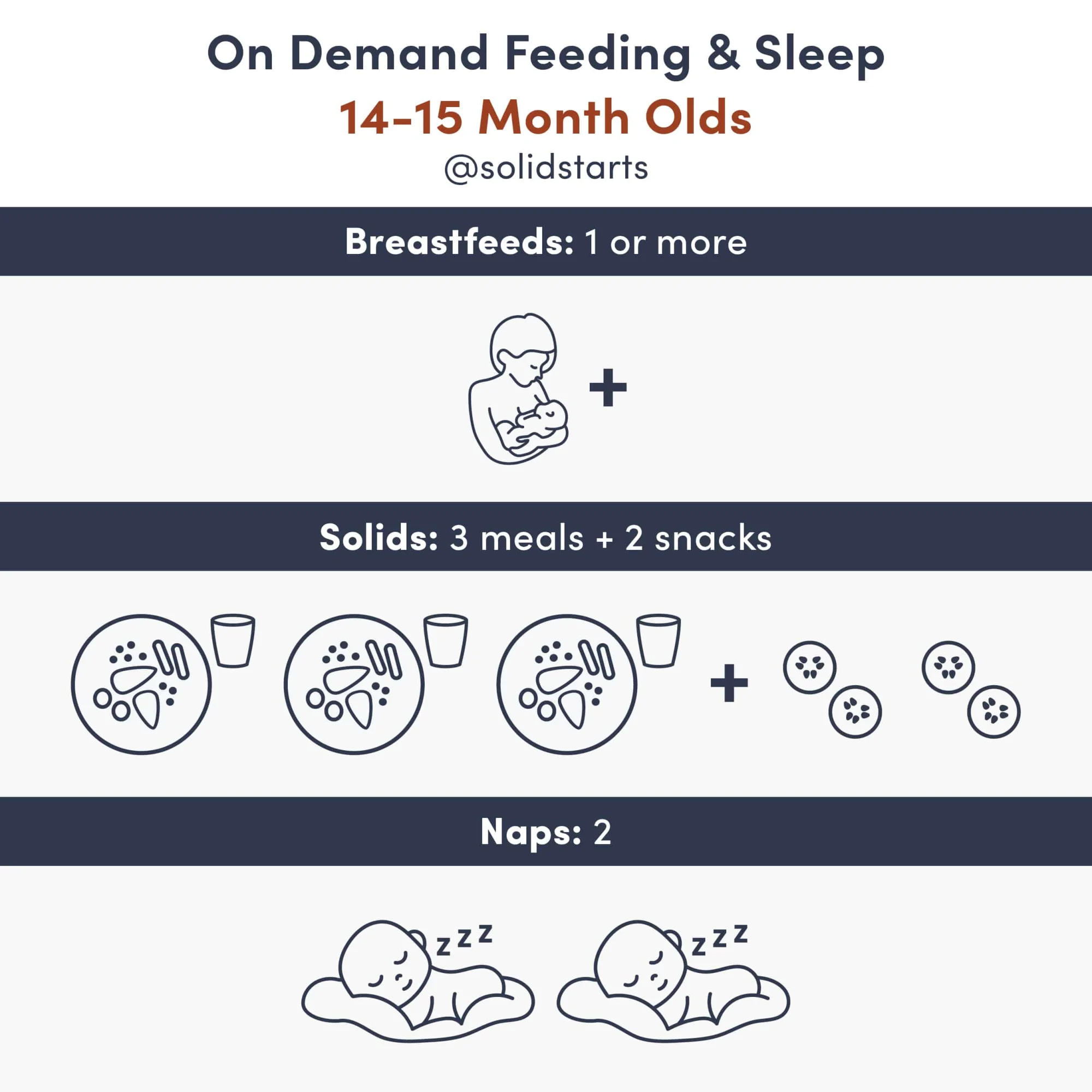
14 to 15 Months Old On-Demand Breastfeeding
Breastfeeds: 1 or more
Solids: 3 meals + 2 snacks
Toddlers could be nursing anywhere from one to many times per day. We support continued on-demand breastfeeding as long as it works for the baby and the parent. At this age, solid food is the primary source of nutrition. Maintain a three-meal schedule and consider offering one or two snacks halfway between each meal. Some babies breastfeed instead of having a snack, but many toddlers are starting to eat foods for snacks as well. If your child isn't coming to the table hungry, or is struggling to eat table food, space out breastfeeding a bit more so the child is hungry for solid food. Continue offering breast/human milk or water in an open or straw cup with meals, alternating between open and straw cups for practice. (See our Cup Drinking page for more information.) Small amounts of cow's milk or other plant-based milk may be offered.
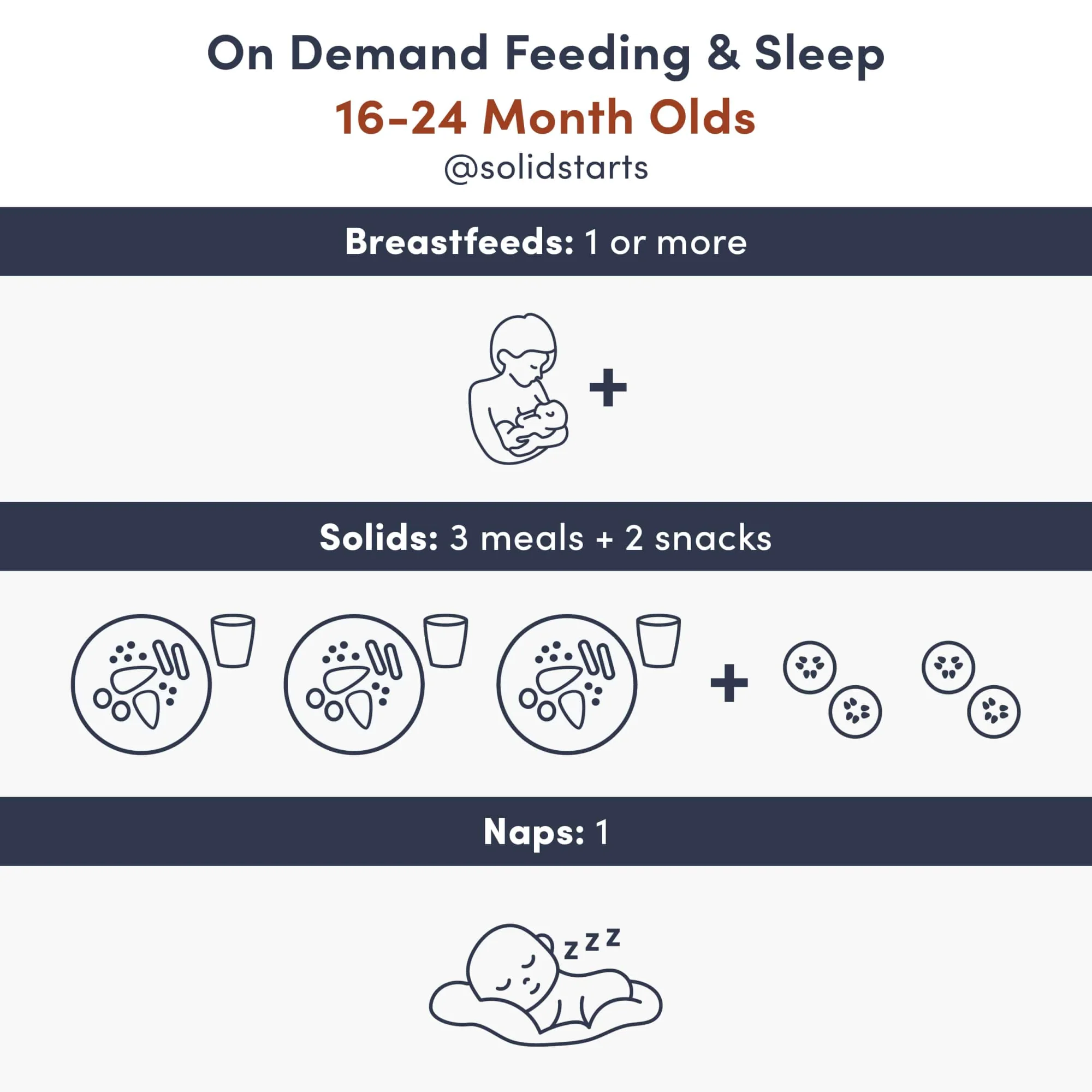
16 to 24 Months Old On-Demand Breastfeeding
Breastfeeds: 1 or more
Solids: 3 meals + 2 snacks
Toddlers could be nursing anywhere from one to many times per day. We support continued on-demand breastfeeding as long as it works for the baby and the parent. At this age, solid food is the primary source of nutrition, and it's important to make sure the child is hungry for at least three meals of table food per day. Some toddlers who continue nursing on demand may not be interested in mid-morning and afternoon snacks, but it's appropriate to offer opportunities for solid snacks. If the child is not eating, or the pediatrician is concerned about weight gain, consider spacing out breastfeeds from table food for at least 2 hours to encourage hunger for solid foods.
A note on night nursing and solids: If your toddler nurses through the night, they may not be interested in eating breakfast. Further, many toddlers will gag and then possibly vomit if their bellies are too full of milk.
Most children move to a 1-nap schedule between 16-18 months of age. At this point, with a nap occurring midday (around 12 noon), offer lunch prior to their naptime, to ensure hunger is not an issue causing a difficult or short nap.
Bottom line on breastfeeding on demand and starting solids
Every child is different, but around 12 months of age solid food should begin to be the primary source of nutrition. By 9 months of age, if baby is not at all interested in exploring solids or even sitting at the table for meals, consider loosely timing some breastfeeds during the day to help baby develop a hunger and interest for table food. As with anything, adapt these guidelines to fit your lifestyle, child, and situation. It’s completely normal and okay for baby or toddler to nurse more or less often than those mentioned above, especially as baby grows and develops. Consult your child’s pediatrician, lactation consultant, or feeding therapist to address your specific needs, concerns, or situation.





